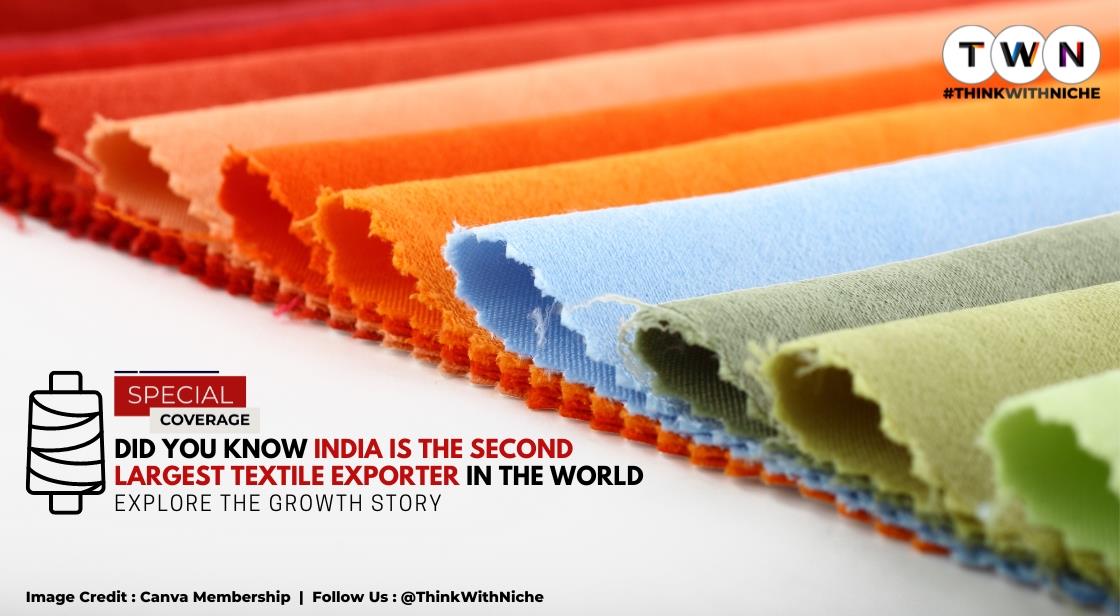Did You Know India Is The Second Largest Textile Exporter In The World- Explore The Growth Story

Blog Post
Because of robust domestic demand as well as export demand, the Indian textile industry's future appears bright. India is pursuing a number of significant initiatives to grow its technical textile industry. Due to the pandemic, there is an increase in demand for technical textiles used to make PPE gear and suits. The sector is being supported by the government through financing and equipment sponsorship.
Leading industry players are attaining sustainability in their products by creating textiles using recyclable natural resources.
As various foreign companies, including Marks & Spencer, Guess, and Next, entered the Indian market, the retail sector has grown quickly due to rising consumerism and disposable income. Growing family incomes, an aging population, and rising demand from industries like real estate, hospitality, and healthcare will all contribute to the expansion of the textile industry.
In the calendar year 2013, India beat competitors including Italy, Germany, and Bangladesh to become the second-largest textile exporter in the world, with China retaining the top position. In today's blog post, we will know what is the growth story behind India becoming the second-largest textile exporter in the world.
One of India's oldest industries, the textile industry in India has been around for many years. The textile business is incredibly diverse, with the capital-intensive sophisticated mills sector at one end of the spectrum and the hand-spun and hand-woven textiles sector at the other. India's textile industry has a significant manufacturing base of a variety of fibres and yarns, including natural fibres like cotton, jute, silk, and wool as well as synthetic/man-made fibres like polyester, viscose, nylon, and acrylic.
The major segment of the textiles industry is the decentralised power looms/hosiery and knitting sector. The textile sector stands out when compared to other national industries because of its close ties to agriculture (for raw materials like cotton) and India's long-standing textile traditions and culture. India's textile industry has the capacity to produce a wide variety of products that are suitable for different market segments both locally and abroad.
The government launched a number of programmes, including the Mega Integrated Textile Region and Apparel (MITRA) Park scheme, the Technology Upgradation Fund Scheme (TUFS), and the Scheme for Integrated Textile Parks (SITP), in an effort to draw private equity and increase employment.
History Of Textile Industry In India
India has been renowned for its textile industries for the last 4,000 years. Although India's textile industry suffered a severe slump under the colonial government, it began to flourish once more in the early nineteenth century.
Although the first textile mill was established in Calcutta in 1818, the actual action took place when the first cotton textile mill was founded in Bombay 36 years later.
Ahmedabad built its first cotton mill in 1861 and started to compete. The Gujaratis' penchant for commerce contributed to Ahmedabad's thriving industrial sector.
In the latter half of the nineteenth century, the textile sector had a rapid expansion. There were 178 textile mills functioning in the nation by the turn of the 20th century. Regrettably, during the early 20th century, a significant famine forced the closure of a number of mills for an extended length of time.
What is textile?
After food, textiles rank as the second most essential good in the world. Moreover, it is consumed by everyone in the world. The identity of a person's cultural, social, economic, political, and religious conventions are symbolised by their textiles.
In fact, it might be used interchangeably with a neighbourhood, a state, or even an entire nation. Textile has developed into a potent medium for self-expression and social influence.
The history of India exemplifies the importance and function of the native culture. Mahatma Gandhi popularized Kadhi cloth and served as an agent of autarky. It was India's way of demonstrating its resiliency and unity. Several political figures still appreciate its importance and wear it now.
The importance of the textiles industry to the Indian economy
One of the largest and oldest industries in India is the textile sector. The textile industry is very diverse, including hand-woven, hand-spun, and numerous mills. Since it is one of the largest sectors, the industry employs around 4.5 crore people, including 35.22 lakh individuals working in handlooms across the country.
India exports a variety of goods and raw materials to other countries, with a value of US$29.8 billion between April and December 2021. By the year 2029, this market is projected to be worth more than US$ 209 billion.
The largest producer of cotton in the world is India. Production for the crop in the period from October 2021 to September 2022 was 360.13 lakh bales. 1.13 million tonnes of cotton yarn were exported from India in 2020–2021.
Indian textile industry has also seen a surge in investment from a number of foreign nations and businesses in addition to our own. The industry (including coloured and printed items) attracted Foreign Direct Investment (FDI) worth US$3.93 billion between April 2000 and December 2021.
India's economy has benefited greatly from the textile sector. The fact that India trades apparel and textiles on a global scale has significantly increased India's Economy and its earnings.
the industry At the same time period, the textile export market grew from USD 14 billion to USD 19 billion. From USD 23 billion to USD 30 billion, the local market increased by USD 7 billion.
What is textile design?
It involves the planning, production, and modification of textiles to meet consumer needs and preferences. The understanding of Indian textile design has advanced substantially over time. After the textile design, items like garments, carpets, draperies, and towels are the finished products. The finished garment can achieve remarkable heights with good textile design.
Due to its abundance of assets and long history with textiles, India has a large scope for textile design and production. The combination of original and traditional design approaches used in production and its connection with agriculture are what set India apart from its global competitors.
The richness of the design is enhanced by the abundance of design guidelines based on the many traditions and concepts of the region. Indian textiles are so ideal for both the domestic and international markets.
Also Read: Growth Story Of Travel And Tourism Industry In India
Market Size of the Indian textile and apparel industry
By 2025–2026, the Indian textile and apparel industry is projected to increase at a 10% CAGR, totalling US$190 billion. India accounts for 4% of the global apparel and textile trade.
The largest producer of cotton in the world is India. During the 2021–2022 cotton season, an estimated 362,18 lakh bales were produced. 338 lakh bales of cotton are anticipated to be consumed domestically in the 2021–22 cotton season. By 2030, India's cotton production is expected to reach 7.2 million tonnes (or 43 million bales of 170 kg each), spurred by rising consumer demand.
Production of fibre in India reached 2.40 MT in FY21 (until January 2021), whereas for yarn, the production amounted to 4,762 million kgs during the same period.
India exported $44.4 billion worth of textiles and apparel (including handicrafts) in FY22, a 41% YoY increase. The US is India's single largest market, and 27% of its total exports in FY22 were textiles and apparel. In FY22, ready-to-wear garment exports, including cotton accessories, were US$6.19 billion.
A total of 4.5 crore people are employed in the textile sector in India, including 35.22 lakh people who work with handlooms.
Different Types of Textile Industries in India
The Indian textile industry, excluding synthetic fibres, can be broadly divided into four types of textiles:
1. Cotton Textile Industry
India produces the most cotton in the world and has the biggest area dedicated to cotton farming. The cotton textile industry is also the second most developed sector overall (in terms of natural fibres).
Geographically speaking, it is the most extensively dispersed industry in the nation. Maharashtra, Gujarat, Tamil Nadu, Uttar Pradesh, West Bengal, Madhya Pradesh, Karnataka, Andhra Pradesh, Kerala, Haryana, Punjab, and Delhi are among the states where it is common.
5.8 million cotton farmers rely on the sector for their living, while cotton is processed and traded by 50 million people.
2. Woollen Textile Industry
India has the third-largest population of sheep worldwide and is the seventh-largest producer of raw wool. Yet, the nation depends on imports of raw wool from Australia and New Zealand due to a significant lack of domestic production. The nation's civilian and military needs are typically met by the woollen textile sector.
Comparatively speaking to cotton production in the nation, the industry is minor. Punjab, Haryana, Rajasthan, Uttar Pradesh, Maharashtra, and Gujarat are some of the top-producing states.
3. Silk Textile Industry
Silk is known as the "queen of all materials" because of its unique qualities. With more than 100 silk textile mills in India, the silk industry there produces more silk than any other country on earth. Moreover, only India produces Mulberry, Tropical Tasar, Oak Tasar, Muga, and Eri varieties of commercial silk.
West Bengal, Andhra Pradesh, Tamil Nadu, and Karnataka are the top-producing states for silk. 90% of the silk produced in India comes from these states. The sector offers significant employment growth potential, inexpensive startup costs, and profit margins for silk farmers.
4. Jute Textile Industry
In terms of production, the cotton industry dominates the jute textile sector. It is common throughout the eastern parts of the nation. Being a sector that is heavily dependent on exports, its survival is entirely dependent upon export success.
The top producers are Assam, Bihar, and West Bengal. In India, West Bengal produces four-fifths of the nation's jute. Many lakhs of jute farm families as well as 0.37 million workers in organised mills depend on the industry for their survival.
You May Like
EDITOR’S CHOICE












